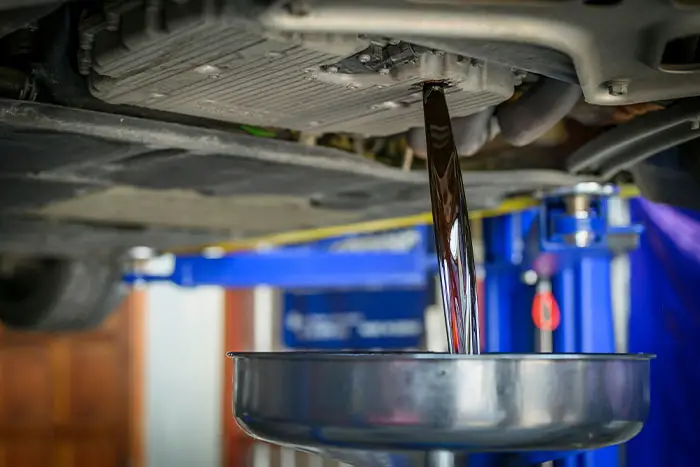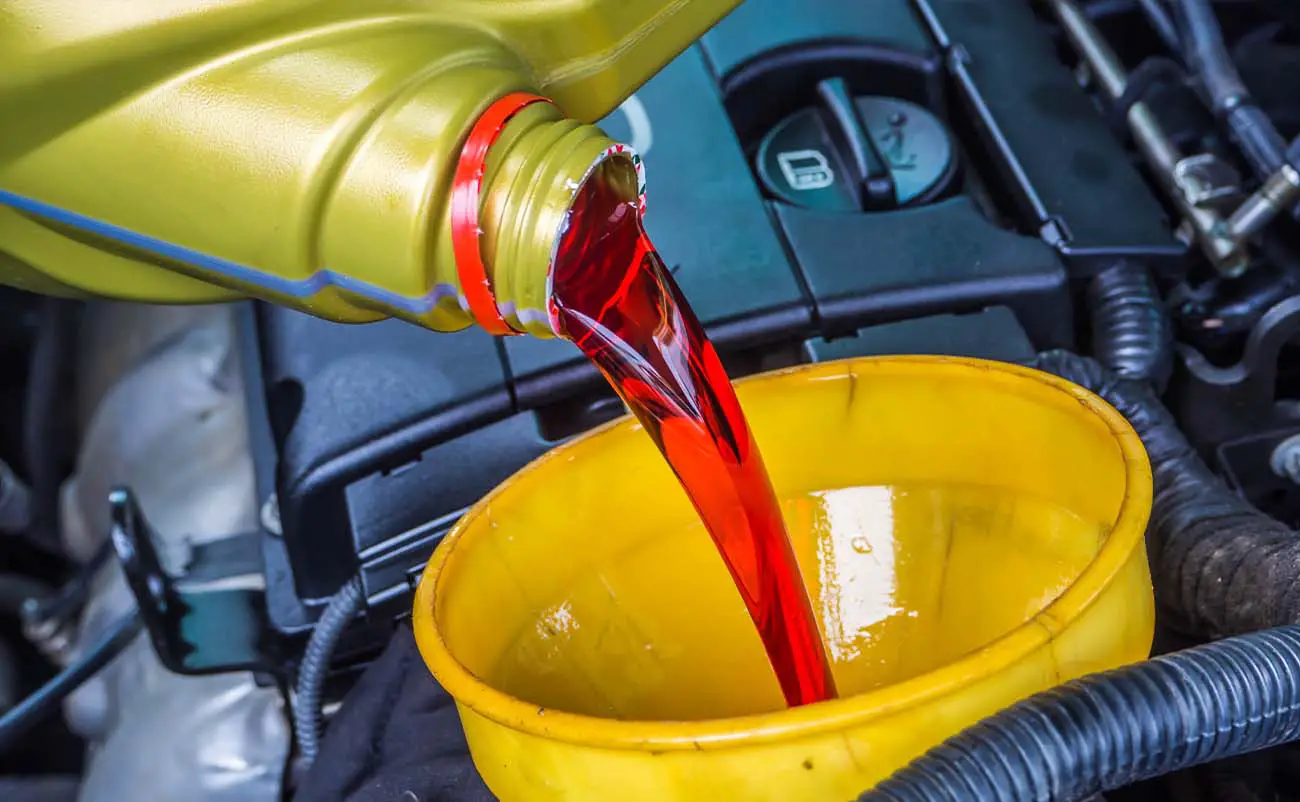Most cars today are equipped with automatic transmissions, and those require regular maintenance. You might not know it, but your transmission contains automatic transmission fluid that breaks down over time. When this happens, the fluid no longer provides lubrication for the internal parts of your transmission as it should. Removing this old fluid and replacing it with fresh new fluid is critical to keeping your transmission operating smoothly for years down the road. Keep reading, and we will explain everything you need to know about a transmission fluid change, including how to perform this job yourself!
Table of Contents
What Is A Transmission Fluid Change?

A transmission fluid change is a process of removing the old transmission fluid from your vehicle and replacing it with new transmission fluid. It sounds pretty self-explanatory. In most cases, this is a straightforward task, and it simply involves dropping the transmission pan and letting the old fluid drain out; some pans even have a drain plug for easy draining of the fluid.
This process is necessary because transmission fluid breaks down and wears out over time. Just like your engine oil, your transmission fluid needs to be changed regularly. Most people would never dream of driving their car forever without performing an oil change. You should look at a transmission fluid change the same way! Granted, you get more life out of transmission fluid than you do engine oil, but it still must be changed at the recommended interval.
Some people prefer a transmission fluid flush instead of a fluid change. We will discuss the differences between these two services more in the next section. The main complaint with fluid changes is that simply draining the fluid does not remove all the old fluid from the transmission system. Up to 40% of the old fluid might still be retained within the torque converter and other areas of the transmission. A flush helps to ensure that all the old fluid is removed from the system.
Transmission Fluid Change VS Transmission Flush
As we mentioned, the biggest drawback to a fluid change is that much of the old fluid remains in the system even after draining. Because of this, your transmission is not filled with entirely new fluid. Some people even choose to perform a second fluid change soon after the first to help ensure that more of the old fluid is removed and new fluid is added. However, that can be time-consuming and expensive. Instead, many people opt for a transmission fluid flush.
A transmission flush is a process by which a flushing machine uses pressure to remove all the old fluid from the system and replace it with new fluid. The transmission cooler lines are disconnected from the system and connected to the flushing machine. The machine acts like a vacuum and removes all the fluid while pumping fresh fluid into the system. This ensures that all of the old fluid is removed during the fluid exchange.
Many people dislike transmission flushes because they say that this pressure in the system can lead to problems. It might push debris or other contaminants into the passages inside the transmission. If a blockage occurs, this can cause major transmission problems. If performed regularly by a qualified mechanic, then a flush should present no problems. However, if your car is long overdue for new fluid, a simple fluid change is probably the best option to avoid potential problems.
Transmission Fluid Change DIY Steps

Many people wonder how to change transmission fluid. A fluid change is not an overly complex procedure, although it can get a little messy. If you decide that you want to attempt this yourself, here are the steps that you need to follow. First, you will need to get a large pan or bucket to catch all the fluid as it drains. Next, locate your transmission pan and determine whether a drain plug is present. If so, remove the drain plug and allow the fluid to drain out!
If no drain plug is present, then you will need to remove the pan itself. It is typically held on by numerous bolts around the edge of the pan. Start by removing the bolts from one corner and allowing the fluid to drain in that one spot to avoid a huge mess. Go ahead and remove all the bolts to drain as much fluid as possible from the system.
While you are in there, go ahead and replace the transmission filter with a new one. You will also need a new pan gasket. Once the new filter is in place, seat the new pan gasket onto the pan and reattach it to the transmission. Make sure that you tighten the pan bolts to the proper torque specs to avoid damage.
Once the pan is reattached, go ahead and fill the transmission with new fluid. You can find the fluid capacity in your owner’s manual, but be sure not to overfill, remembering that not all of the old fluid drained out. If you are wondering how to check transmission fluid, you should check the fluid level using your transmission dipstick and keep the car running at operating temperature when checking the fluid. Once it is at the proper level, you can shut off the car, and you are done!
How Often To Perform A Fluid Change
If you are wondering when to change transmission fluid, you should follow your manufacturer’s recommendations. Most manufacturers recommend a fluid change service interval of 40,000 to 50,000 miles. However, if you start to notice issues, then you might need one sooner. This could be a slipping transmission, shifting problems, or overheating. You might also see that the fluid on the dipstick is dark or smells burned.
As the fluid in your car’s transmission ages, it breaks down and no longer provides proper lubrication to the moving parts inside the transmission. This can lead to transmission issues and even transmission failure if left unattended for too long. If you have questions about whether or not you need a fluid change, you can always contact your local dealership. Go ahead and make a fluid change part of your regular maintenance schedule.
Automatic Transmission Fluid Cost
So, how much is transmission fluid? The cost of a fluid change depends mainly on the amount of automatic transmission fluid (ATF) that your vehicle requires. This fluid typically ranges in price from about $4 to $7 per quarter. However, some vehicles require 16 quarts or more of fluid! You can see that even with the low pricing per quart, that can start to add up!
The type of fluid required by your vehicle manufacturer can also play a role in the cost. Some vehicles require fluid with special additives and detergents, and this fluid is usually more expensive and will cause your fluid change to be more costly. On average, you can expect to pay $300 to $500 for a fluid change at a reputable transmission service center. This price is generally a little higher than a transmission flush because the fluid change requires more labor time—a flush averages around $300 and sometimes less.
The Bottom Line
While folks with manual transmissions do not need to be as concerned, those with automatic transmissions must remember to perform regular fluid changes. Keeping fresh fluid in your transmission is the key to keeping it running properly over the life of your vehicle. Failure to do so could leave you with a broken transmission and a large towing bill. That is never fun—especially when it could be avoided with a simple maintenance procedure.
Frequently Asked Questions
Do you really need to change transmission fluid?
Yes, absolutely! Whether you decide to perform a fluid change or fluid flush is up to you, but you must change your transmission fluid as part of your maintenance schedule. Your owner’s manual will specify the recommended interval, and you should always change your fluid if you start to notice any transmission issues. This is an essential maintenance item that cannot be overlooked or ignored.
What happens if you don’t change transmission fluid?
Failure to change your fluid can lead to your transmission overheating, slipping, or shifting incorrectly. If it goes on for too long, it can lead to total transmission failure. Repairing or replacing a transmission is expensive, so you should do everything possible to avoid that. Changing your fluid is one of the things that can help you avoid costly repairs. If you wonder how often to change transmission fluid, you should do it every 40,000 – 50,000 miles.
What is the purpose of transmission fluid?
Transmission fluid lubricates the internal moving parts of your transmission. In addition, it helps to transfer heat out of the transmission. The cooling that the fluid provides is critical to keeping your transmission in operation. Once the fluid becomes old and contaminated, it can no longer perform these functions successfully.
What are the symptoms that my transmission fluid needs to be changed?
You might notice your transmission slipping or shifting irregularly. In addition, the fluid may appear dark or have a burnt smell when you check the dipstick. Any of these symptoms signal that your fluid should be changed immediately. Many people ask, “How often should you change transmission fluid?” Most people recommend every 50,000 miles or so, but you should do it right away if you see any of the signs mentioned here.

